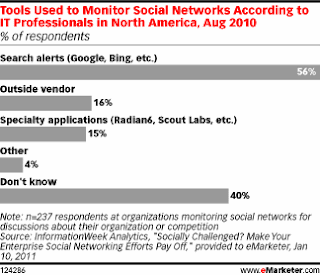eMarketer reports that online monitoring of commentary about your brand or product is vitally important. Even if a company isn't involved in social media activities, customers almost definitely are and sometimes their conversations can end up in the news media.
According to a survey of business technology professionals by InformationWeek Analytics, most companies are relying on the proven low-tech solutions to the social media monitoring challenge.
Note: for those marketers who need some guidance, I maintain a list of free social media tools.
Why the DIY Monitoring Approach is Preferred
Most companies are using basic tools, such as Google Alerts, to monitor online discussions. Outsourcing the task or using a dedicated application for the purpose was relatively uncommon. This is not surprising, since the free tools are easy to use and they're also effective.
That said, the typical survey respondent approach to dealing with online engagement suggested many were not ready for potential negative commentary on social sites.
About a third of companies had a formal process for posting announcements to social networks, and more than a quarter had a plan for dealing with employee postings deemed inappropriate. No doubt, these are the typical "what not to do" policy documents that are now commonplace.
But many were unready for the comments by their public stakeholders. Just 21 percent had a process for responding to complaints on eCommerce sites, and even fewer knew how to respond to commentary problems on Facebook or Twitter.
Overcoming the Social Media Bystander Phenomenon
More than two in five survey respondents had no processes in place for any social media content that might turn up in a monitoring program. Again, that's not surprising, since the punitive wording used in most social media policy documents leaves employees with the impression that doing nothing is preferred.
eMarketer believes that while negative buzz can be a headache for marketers, social media also offers an opportunity to be responsive to customers, demonstrate good customer service, and even improve products or services -- based on legitimate complaints and suggestions.
But how can employees do that if they're afraid to engage online?
Clearly, the lack of a plan for responding to comments leaves marketers vulnerable. If a bad customer experience spreads unchecked, then the marketing leadership is responsible. Therefore, the real social media challenge is enabling employees to actively engage -- and thereby do something meaningful and deliberate with the monitoring results.
